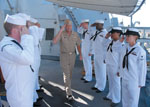Naval Intelligence Ramps up Activities
 |
| The U.S. Navy guided missile frigate USS McInerney tows a semi-submersible craft seized by several U.S. Coast Guard law enforcement officers embarked aboard the frigate. The Navy and the Coast Guard are joining forces in a National Maritime Intelligence Center to address new oceangoing intelligence requirements. |
A global reach now embraces maritime domain awareness across agencies.
(Editor's Note: This is an updated version of the article that appeared in the February issue of SIGNAL Magazine.)
The U.S. Navy is revamping its intelligence structure with command upgrades and a new set of priorities designed to rebuild naval intelligence. This effort includes the creation of a new maritime intelligence office that will move the Navy out of providing service-specific intelligence fully into the realm of national intelligence.
These efforts are a departure from the recent approach to naval intelligence, and they also represent a U-turn from the post-Cold-War reductions in activities. The Global War on Terrorism and the uncertainties exhibited by several nations’ navies have moved
The Navy is upgrading the position of director of naval intelligence to vice admiral. Vice Adm. David J. Dorsett, USN, is the new director. He describes naval intelligence as a community undergoing significant changes down to the nature of its mission.
Some changes have been long underway. The past 10 years have seen a 50-percent growth in the civilian work force and a 25-percent growth in uniformed personnel in naval intelligence, the admiral reports. But other major shifts are relatively new, and some operational architectures are still in the development stage.
In addition, the Office of Naval Intelligence receives four new subordinate commands: the Nimitz Operational Intelligence Center, the Farragut Technical Analysis Center, the John F. Kennedy Irregular Warfare Center and the Grace Hopper Information Services Center. These four centers will stand up around the end of this month.
The Nimitz center focuses on support to the fleet as well as other U.S. Defense Department organizations involved with maritime operational intelligence activities. The Farragut center aims at developing a deep understanding of foreign naval weapon systems and command, control, communications, computers, intelligence, surveillance and reconnaissance (C4ISR) in the maritime domain. The Kennedy center focuses specifically on supporting Navy special warfare and expeditionary commands. The Hopper center will provide the information technology backbone for naval intelligence.
The Navy’s intelligence changes do not stop at its shores, however. It is working to structure interaction with other government organizations that can use or provide valuable intelligence related to seagoing issues. To that end, the Navy is helping create a new entity dedicated to maritime intelligence.
Out of the Office of Naval Intelligence (ONI) and the U.S. Coast Guard Intelligence Coordination Center (ICC) in
The key difference between the NMIC and the existing
The importance of maritime intelligence is being elevated, and its requirements that currently are not being fulfilled will be addressed by the creation of the NMIC, Adm. Dorsett suggests. It represents a shift away from pure service intelligence to a more broad approach.
He relates that his tasking from Adm. Gary Roughead, USN, chief of naval operations (CNO), is to return naval intelligence to “prominence and dominance.” He says naval intelligence ceded its position of prominence following the end of the Cold War. With the Soviet Union dissolved and its navy no longer a threat,
Over the years, those joint centers have not been able to meet all the Navy’s intelligence requirements. So the ONI created operational detachments and has moved those groups into areas in which naval personnel have deployed forward. Adm. Dorsett relates that the Navy is letting his office experiment with different structures and mechanisms for delivering capability. Any that do not work will be discarded.
For information dominance, naval intelligence must be able to deliver information so that operational commanders and other naval leaders can be assured of decision superiority, Adm. Dorsett states. This decision superiority might be applied to actions ranging from acquisition to warfighting.
For his mission as director of naval intelligence, Adm. Dorsett lists three priorities. The first is to educate naval intelligence personnel in the new disciplines of intelligence in the post-Cold-War era. Naval intelligence personnel traditionally have viewed their art in general terms, but now that approach is an unaffordable luxury, Adm. Dorsett implies. He foresees a naval intelligence community whose members are far more specialized and sub-specialized than tradition holds. Achieving the necessary degree of specialization will require a shift away from a basic training approach toward a deep education capability.
The admiral describes this as a paradigm shift for naval intelligence and the Navy as a whole. He continues that he already has transferred some money and provided guidance for increased educational opportunities, and that thrust should accelerate throughout the year.
 |
| Vice Adm. David J. Dorsett, USN, director of naval intelligence, arrives aboard the guided missile destroyer USS Farragut. Improving naval intelligence will require major personnel changes both in assignments and in skills. |
Adm. Dorsett’s third priority focuses on information dominance, and the admiral seeks a “penetrating understanding” of potential adversaries. These targets range from established enemies such as terrorist groups and pirates to countries that potentially might come to disagreement with the
Developing knowledge of these potential adversaries is essential for having an effective intelligence organization, the admiral maintains. This requires a top-notch work force that goes beyond “good enough,” and it calls for Ph.D.-level skills from people who spend years building understanding, he says.
However, the admiral is not certain that he will want to increase personnel numbers beyond the fiscal year 2009 budget. He is evaluating whether he will need additional personnel in the out years, and he expects the new administration to provide input through its overall defense strategy. “I’m looking at anywhere from taking reductions to adding capability,” he says. “Right now, I’m very satisfied with the current manpower we have. What we are looking at instead of adding manpower is how to do business smarter with the same level of resources giving more capability and permitting you to train or educate your people in more detail.”
A major shortcoming exposed by the onset of the Global War on Terrorism was a lack of human intelligence (HUMINT) capability within the Navy, the admiral relates. The Navy since has built up its HUMINT capabilities, and the service is consolidating counterintelligence and HUMINT. Adm. Dorsett explains that because these two functions are similar, they can be combined to break down barriers and improve synergy. Some combatant commands have this mechanism, but the other services maintain them as separate entities. Some implementation already has taken place in the Navy, and preliminary reviews are quite positive, he says.
Over the past few years, the Navy made only a limited investment in special warfare, which forced it to realign its forces for ashore counterinsurgency operations or for the war on terrorism. Other disciplines also suffered. The admiral relates that his office has invested more than 500 personnel in higher priority efforts. Beneficiaries include Navy special warfare support, the Naval Expeditionary Intelligence Command, HUMINT, Chinese naval forces analysis, Iranian naval forces analysis and technical analysis.
His office also is investing in maritime domain awareness and tools that would be migrated into networks. The Navy’s Consolidated Afloat Networks and Enterprise Services, or CANES, serves as the fleet’s backbone, and naval intelligence is evaluating applications and tools that could fit into that network. The Distributed Common Ground System (DCGS) is one element, he notes, and his office is partnering with the National Security Agency on its real-time regional gateway, or RTRG. The admiral admits that he does not have a clear picture of how well RTRG would migrate into CANES, but his office is investigating it. RTRG already is being used successfully in
Another ongoing initiative is the fleet intelligence alignment. The admiral relates that the afloat intelligence presence largely has not changed since the Vietnam War era. “When you look at the fact that [during Vietnam] we were using teletypes to get information to you, and we now have a significant information technology capability—yet we continue to maintain the same footprint and structure—you say, ‘Is that the right mechanism?’ The answer is no,” he declares.
The admiral allows that his office is looking at reducing the afloat footprint to a core capability, to which increased capability would be added in a time of need. This direct support approach is not unusual within the Navy, he notes, but it has not been tried yet in naval intelligence. Reach-back capabilities would be established in a couple of areas, and this will allow the Navy to train large groups of people on land. Naval intelligence already has received feedback on a preliminary proposal for realignment, and by the end of this month it should be ready for presentation to the CNO.
Relying on a reach-back capability brings up the issue of bandwidth. Navy ships are extremely limited in bandwidth capacity; and while the Navy is expanding bandwidth, it is not approaching the extent necessary to reach intelligence requirements. “It is not an optimal situation within the Navy,” Adm. Dorsett observes. “We are bandwidth-limited, so until we get significant bandwidth, we will not be in an optimal operating environment.”
This bandwidth limitation places greater emphasis on ashore analysis, the admiral notes, so that intelligence products instead of raw data flow over the afloat networks. Intelligence officials are taking these factors into account as they determine the types of intelligence data that flow across the network. Issues include how much information needs to go forward and the bandwidth needed to support that. This dialogue is taking place across the Navy, the admiral adds.
Adm. Dorsett’s office is working to migrate one of its classified networks into the larger Navy information architecture. This stovepiped system will become part of the Next Generation Enterprise Network.
Naval intelligence also is examining future information system investments. These could include airborne ISR capabilities; ashore cyber footprints; and unmanned air, surface or undersea vehicles. Commitments will depend on many factors, including a large overview of Navy requirements.
“Moving beyond intelligence, it is my belief that we need a much more detailed understanding of what the Navy needs in the information age—from what our concepts should be, our strategies, to ultimately our architectures,” Adm. Dorsett posits.
With the Navy moving toward an open architecture, Adm. Dorsett decries the problem of industry providing it with proprietary units. Businesses should partner to deliver open-architecture systems. With these teams working with the Navy, businesses are empowered to develop “the art of the possible” in a way that would meet Navy requirements, he says.
Adm. Dorsett is calling on industry also to help drive acquisition reform. Only by partnering with the Defense Department can industry help bring about necessary changes for information technology acquisition. “If we’re going to have information dominance, you can’t do it with the acquisition timeline that we have,” he says. “You don’t want to throw the oversight out, but what you need to do is speed it up and have a mechanism in place to deliver things much more quickly.
“Frankly, industry can help in one regard: by being vocal about the need for acquisition reform,” he emphasizes. “That’s an area where we can partner.”
Web Resource
Office of Naval Intelligence/NMIC: www.nmic.navy.mil



Comments